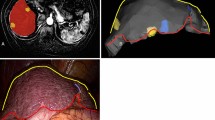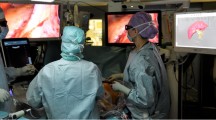Abstract
Background
The aim of this study was to assess the performance of our augmented reality (AR) software (Hepataug) during laparoscopic resection of liver tumours and compare it to standard ultrasonography (US).
Materials and methods
Ninety pseudo-tumours ranging from 10 to 20 mm were created in sheep cadaveric livers by injection of alginate. CT-scans were then performed and 3D models reconstructed using a medical image segmentation software (MITK). The livers were placed in a pelvi-trainer on an inclined plane, approximately perpendicular to the laparoscope. The aim was to obtain free resection margins, as close as possible to 1 cm. Laparoscopic resection was performed using US alone (n = 30, US group), AR alone (n = 30, AR group) and both US and AR (n = 30, ARUS group). R0 resection, maximal margins, minimal margins and mean margins were assessed after histopathologic examination, adjusted to the tumour depth and to a liver zone-wise difficulty level.
Results
The minimal margins were not different between the three groups (8.8, 8.0 and 6.9 mm in the US, AR and ARUS groups, respectively). The maximal margins were larger in the US group compared to the AR and ARUS groups after adjustment on depth and zone difficulty (21 vs. 18 mm, p = 0.001 and 21 vs. 19.5 mm, p = 0.037, respectively). The mean margins, which reflect the variability of the measurements, were larger in the US group than in the ARUS group after adjustment on depth and zone difficulty (15.2 vs. 12.8 mm, p < 0.001). When considering only the most difficult zone (difficulty 3), there were more R1/R2 resections in the US group than in the AR + ARUS group (50% vs. 21%, p = 0.019).
Conclusion
Laparoscopic liver resection using AR seems to provide more accurate resection margins with less variability than the gold standard US navigation, particularly in difficult to access liver zones with deep tumours.






Similar content being viewed by others
References
Slakey DP, Simms E, Drew B, Yazdi F, Roberts B (2013) Complications of liver resection: laparoscopic versus open procedures. JSLS 17:46–55. https://doi.org/10.4293/108680812X13517013317716
Landi F, De Angelis N, Scatton O, Vidal X, Ayav A, Muscari F, Dokmak S, Torzilli G, Demartines N, Soubrane O, Cherqui D, Hardwigsen J, Laurent A (2017) Short-term outcomes of laparoscopic vs. open liver resection for hepatocellular adenoma: a multicenter propensity score adjustment analysis by the AFC-HCA-2013 study group. Surg Endosc 31:4136–4144. https://doi.org/10.1007/s00464-017-5466-4
Goumard C, Farges O, Laurent A, Cherqui D, Soubrane O, Gayet B, Pessaux P, Pruvot F-R, Scatton O, Associationfor Hepatobiliary and Pancreatic Surgery, F (2015) An update on laparoscopic liver resection: The French hepato-bilio-pancreatic surgery association statement. J Visc Surg 152:107–112. https://doi.org/10.1016/j.jviscsurg.2015.02.003
Fretland ÅA, Dagenborg VJ, Bjørnelv GMW, Kazaryan AM, Kristiansen R, Fagerland MW, Hausken J, Tønnessen TI, Abildgaard A, Barkhatov L, Yaqub S, Røsok BI, Bjørnbeth BA, Andersen MH, Flatmark K, Aas E, Edwin B (2018) Laparoscopic versus open resection for colorectal liver metastases: The OSLO-COMET randomized controlled trial. Ann Surg 267:199–207. https://doi.org/10.1097/SLA.0000000000002353
Phutane P, Buc E, Poirot K, Ozgur E, Pezet D, Bartoli A, Le Roy B (2018) Preliminary trial of augmented reality performed on a laparoscopic left hepatectomy. Surg Endosc 32:514–515. https://doi.org/10.1007/s00464-017-5733-4
Su L-M, Vagvolgyi BP, Agarwal R, Reiley CE, Taylor RH, Hager GD (2009) Augmented reality during robot-assisted laparoscopic partial nephrectomy: toward real-time 3D-CT to stereoscopic video registration. Urology 73:896–900. https://doi.org/10.1016/j.urology.2008.11.040
Bourdel N, Collins T, Pizarro D, Debize C, Grémeau A-S, Bartoli A, Canis M (2017) Use of augmented reality in laparoscopic gynecology to visualize myomas. Fertil Steril 107:737–739. https://doi.org/10.1016/j.fertnstert.2016.12.016
Collins T, Pizarro D, Bartoli A, Bourdel N, Canis M (2014) Computer-aided laparoscopic myomectomy by augmenting the uterus with pre-operative MRI data. ISMAR - IEEE International Symposium on Mixed and Augmented Reality
Ieiri S, Uemura M, Konishi K, Souzaki R, Nagao Y, Tsutsumi N, Akahoshi T, Ohuchida K, Ohdaira T, Tomikawa M, Tanoue K, Hashizume M, Taguchi T (2012) Augmented reality navigation system for laparoscopic splenectomy in children based on preoperative CT image using optical tracking device. Pediatr Surg Int 28:341–346. https://doi.org/10.1007/s00383-011-3034-x
Soler L, Nicolau S, Pessaux P, Mutter D, Marescaux J (2014) Real-time 3D image reconstruction guidance in liver resection surgery. Hepatobiliary Surg Nutr 3:73–81. https://doi.org/10.3978/j.issn.2304-3881.2014.02.03
Ntourakis D, Memeo R, Soler L, Marescaux J, Mutter D, Pessaux P (2016) Augmented reality guidance for the resection of missing colorectal liver metastases: an initial experience. World J Surg 40:419–426. https://doi.org/10.1007/s00268-015-3229-8
Özgür E, Koo B, Le Roy B, Buc E, Bartoli A (2018) Preoperative liver registration for augmented monocular laparoscopy using backward-forward biomechanical simulation. Int J Comput Assist Radiol Surg 13:1629–1640. https://doi.org/10.1007/s11548-018-1842-3
Le Roy B, Ozgur E, Koo B, Buc E, Bartoli A (2019) Augmented reality guidance in laparoscopic hepatectomy with deformable semi-automatic computed tomography alignment (with video). J Visc Surg 156:261–262. https://doi.org/10.1016/j.jviscsurg.2019.01.009
Le Roy B, Abdallah M, Espinel Y, Calvet L, Pereira B, Ozgur E, Pezet D, Buc E, Bartoli A (2020) A case series study of augmented reality in laparoscopic liver resection with a deformable preoperative model. Surg Endosc 34:5642–5648. https://doi.org/10.1007/s00464-020-07815-x
Chauvet P, Collins T, Debize C, Novais-Gameiro L, Pereira B, Bartoli A, Canis M, Bourdel N (2018) Augmented reality in a tumor resection model. Surg Endosc 32:1192–1201. https://doi.org/10.1007/s00464-017-5791-7
Chabrot P (2016) Modèle de simulation en radiologie. 5ème colloque francophone de simulation en santé
Schneider C, Thompson S, Totz J, Song Y, Allam M, Sodergren MH, Desjardins AE, Barratt D, Ourselin S, Gurusamy K, Stoyanov D, Clarkson MJ, Hawkes DJ, Davidson BR (2020) Comparison of manual and semi-automatic registration in augmented reality image-guided liver surgery: a clinical feasibility study. Surg Endosc 34:4702–4711. https://doi.org/10.1007/s00464-020-07807-x
Golse N, Petit A, Lewin M, Vibert E, Cotin S (2020) Augmented reality during open liver surgery using a markerless non-rigid registration system. J Gastrointest Surg. https://doi.org/10.1007/s11605-020-04519-4
Lau LW, Liu X, Plishker W, Sharma K, Shekhar R, Kane TD (2019) Laparoscopic liver resection with augmented reality: a preclinical experience. J Laparoendosc Adv Surg Tech A 29:88–93. https://doi.org/10.1089/lap.2018.0183
Luo H, Yin D, Zhang S, Xiao D, He B, Meng F, Zhang Y, Cai W, He S, Zhang W, Hu Q, Guo H, Liang S, Zhou S, Liu S, Sun L, Guo X, Fang C, Liu L, Jia F (2020) Augmented reality navigation for liver resection with a stereoscopic laparoscope. Comput Methods Programs Biomed 187:105099. https://doi.org/10.1016/j.cmpb.2019.105099
Acknowledgements
This study benefitted from the financial support of a 2019-2020 CNRS pre-transfer project and of the 2020-2023 cancéropôle CLARA Proof-of-Concept project AIALO.
Author information
Authors and Affiliations
Corresponding author
Ethics declarations
Disclosures
Mourad Adballah, Yamid Espinel, Lilian Calvet, Bruno Pereira, Bertrand Le Roy, Adrien Bartoli, Emmanuel Buc have no conflicts of interest or financial ties to disclose.
Additional information
Publisher's Note
Springer Nature remains neutral with regard to jurisdictional claims in published maps and institutional affiliations.
Supplementary Information
Below is the link to the electronic supplementary material.
Supplementary file1 (MP4 50218 kb)
Rights and permissions
About this article
Cite this article
Adballah, M., Espinel, Y., Calvet, L. et al. Augmented reality in laparoscopic liver resection evaluated on an ex-vivo animal model with pseudo-tumours. Surg Endosc 36, 833–843 (2022). https://doi.org/10.1007/s00464-021-08798-z
Received:
Accepted:
Published:
Issue Date:
DOI: https://doi.org/10.1007/s00464-021-08798-z




